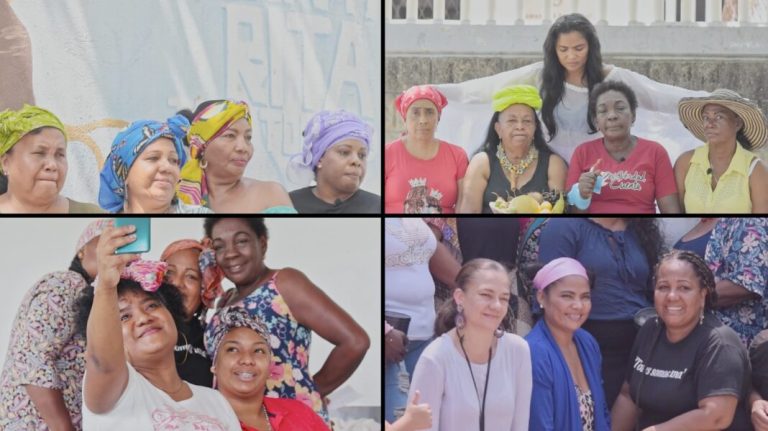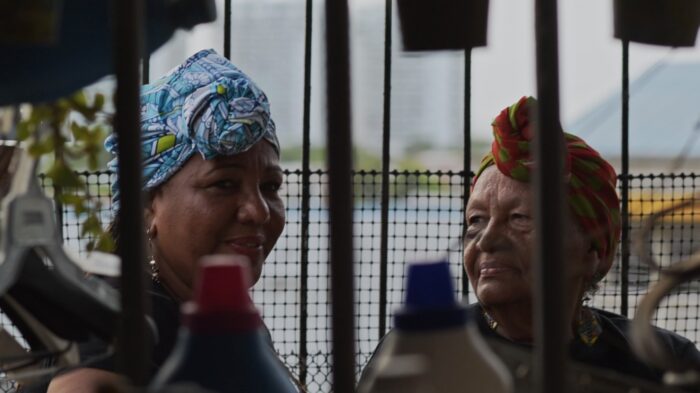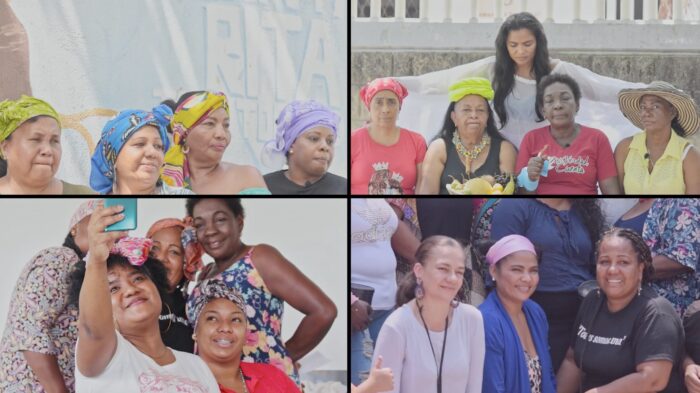
Together We Heal: Women, Art and Resistance
10 November, 2023The documentary Together We Heal: Women, Art and Resistance tells the story of a group of women who have come together to heal their embodied suffering as predominantly Afro-Indigenous women who have been displaced. Grupo Artístico de Mujeres Espejo, based in the Santa Rita neighbourhood of Cartagena, was founded by mother-daughter duo Josefa and Rosiris. Their activities grew out of the need for peace activist and community leader Josefa to tell her own story. As narrated through the short documentary, the group approach healing through the lens of storytelling and art.
The short documentary film Together We Heal: Women, Art and Resistance was co-created by the women of Mujeres Espejo and an international group of creatives from Colombia and the UK. It seeks to shed light on the importance of art and storytelling as a form of individual and collective healing, and to showcase this particular case of feminist resistance. It does so by focusing on the leadership of and relationship between Josefa and Rosiris, founders of Grupo Artístico de Mujeres Espejo.
For us, this documentary was an experience of introspection and healing. As women victims of the Colombian armed conflict, our bodies hold so much pain and trauma. It gave us the opportunity to search inside ourselves and share our stories, through music, dance and photography. But it also gave us the opportunity to see ourselves on screen; to reflect on how far we’ve each come and to witness the love and solidarity between us.
Rosiris Murillo Morelo, Director of Grupo Artístico de Mujeres Espejo.

Colombia has been traumatized by one of the world’s longest civil wars. Despite the 2016 peace agreement between the Colombian government and the FARC-EP officially putting an end to an armed conflict dating back to the 1960s, everyday life for many people across Colombia continues to be shaped by fear. This is particularly true for marginalized groups, such as Afro-Colombian communities and Indigenous populations, as well as women and children.
Since the 1960s, violence and fearmongering, initially concentrated in rural parts of the country, has fed a constant trend of rural-urban displacement. This has accelerated the process of urbanization in Colombia and has placed Colombia second in the world, after Syria, in terms of its displaced population. While there are documented cases of mass displacements of entire communities – particularly Afro-Colombian and Indigenous communities – the vast majority of displacements have occurred ‘gota a gota’ [drop by drop]. Individual families have been forced to flee their homes, uproot themselves from their personal networks, and head towards the urban periphery to seek safety.
Once they reach the city, many internally displaced peoples (IDPs) are re-victimized by a racist, patriarchal, and classist society. Living alongside the urban poor, they face similar structural violence, a lack of socioeconomic opportunities, and unstable living conditions. In these new settings, IDPs find themselves faced with the prospect of re-building a meaningful life. As the majority of displaced people are women and children – with many being single parents and heads of households – this burden ultimately falls on women. This is the case for displaced women across Colombia, who have come together to address their victimization in creative ways.

The Caribbean city of Cartagena is just one receptor city in Colombia’s devastating picture of internal displacement. Over the years, Cartagena has become home to IDPs from the nearby Montes de María – a mountainous region severely affected by the armed conflict – but also to displaced people and families from further afield, such as rural areas of Antioquia. More recently, the city has seen an influx of Venezuelan migrants, contributing to a wider growing refugee crisis in the country.
Once Spanish America’s largest slave port, Cartagena is a registered World Heritage Site. Its colonial walled city, Andalusian-style architecture, and Caribbean beaches have earned it the nickname ‘la heroica’ [the heroic]. But a mere 15-minute drive from the touristic centre is the barrio popular of Santa Rita. Like other barrios populares, despite the short distance, Santa Rita is poorly connected to the touristic centre. Public transport is expensive and routes are unaccommodating and do not serve the needs of the community. Local public amenities and infrastructure don’t match up to those of the glamorous touristic centre and hyper-wealthy Boca Grande area, which is indicative of systemic failure of the municipal government to sufficiently invest in working-class neighbourhoods like Santa Rita. This creates the sense of two disconnected cities, the formal and the informal, characterized by vast inequality.
“From their own suffering and inherited trauma, they have built an extensive network of women dedicated to sharing and healing.”
Shared courtesy of Latin America Bureau, the original article can be found here.
Follow Sounds and Colours: Facebook / Twitter / Instagram / Mixcloud / Soundcloud / Bandcamp
Subscribe to the Sounds and Colours Newsletter for regular updates, news and competitions bringing the best of Latin American culture direct to your Inbox.

